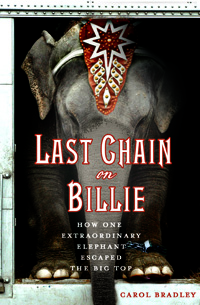A Weighty Biography
Carol Bradley traces the life of a circus elephant brutally abused for two decades before finally finding peace at Hohenwald’s Elephant Sanctuary
If there is a parental notion more twisted or divergent from reality than the idea that circuses represent wholesome family fun, it would be interesting to know what it is. In her new book Carol Bradley (author of Saving Gracie: How One Dog Escaped the Shadowy World of American Puppy Mills) can certainly enlighten the naïve. Meticulously researched, Last Chain on Billie: How One Extraordinary Elephant Escaped the Big Top is a heartrending biography of an Asian elephant separated at a young age from her family and brutalized for decades by trainers and an impossible life on the road. Woven throughout Billie’s story—which, mercifully, lands her finally at The Elephant Sanctuary in Hohenwald, Tennessee—is also a history of the bizarre and perverse form of entertainment known as the circus.
 Billie was born in India and first surfaced in the United States in 1966 at the tender age of four, still very young for an animal that can live past sixty in semi-natural or natural conditions. After being wrenched from her family, Bradley writes, Billie’s treatment almost certainly followed the course of all circus-bound baby elephants: repeatedly beaten, starved for weeks on end, and eventually transported to the U.S. on a fifteen-hour flight, packed tight in a wooden crate with all four legs shackled.
Billie was born in India and first surfaced in the United States in 1966 at the tender age of four, still very young for an animal that can live past sixty in semi-natural or natural conditions. After being wrenched from her family, Bradley writes, Billie’s treatment almost certainly followed the course of all circus-bound baby elephants: repeatedly beaten, starved for weeks on end, and eventually transported to the U.S. on a fifteen-hour flight, packed tight in a wooden crate with all four legs shackled.
At Southwick’s Zoo in Mendon, Massachusetts, four-year-old Billie was known as Popsicle. Given the contrast in climate, the relative solitude, and the small enclosure, the zoo was no place for a young Asian elephant. But it was nothing compared to what she experienced when she was sold at age ten to a circus. Billie performed for twenty-one years with a group that became known as “the Hawthorn Five” because the Hawthorn Corporation, which was repeatedly cited for animal-cruelty violations, leased the elephants to circuses around the country.
“How different her life had become since those early days with her mother when she was free to wander in the jungle of her homeland, surrounded by her family and the sights and smells of nature,” Bradley writes of Billie’s time with Hawthorn. “Her life [was] diminished to the same mind-numbing routine: riding thousands of miles a year in the back of a semi, chained in place. Led out to perform eight minutes at a time in one cacophonous, glaringly lit ring after another.”
 Bradley writes in unyielding detail, which is often very upsetting to read, about the ways in which Billie and her peers were subjected to a series of brutal trainers who used bullhooks to punish them. They were prodded and stabbed in their feet and around their ears, some of the most sensitive areas for elephants, in an effort to make them utterly defenseless and submissive. “Under the klieg lights and to the sounds of earsplitting music, she performed her stunts before children who were often too preoccupied with the plastic swords, whoopee cushions, and inflatable crayons bought for them on the way in,” Bradley writes. “Adults in the audience had no idea what the elephants had suffered in the name of entertainment.”
Bradley writes in unyielding detail, which is often very upsetting to read, about the ways in which Billie and her peers were subjected to a series of brutal trainers who used bullhooks to punish them. They were prodded and stabbed in their feet and around their ears, some of the most sensitive areas for elephants, in an effort to make them utterly defenseless and submissive. “Under the klieg lights and to the sounds of earsplitting music, she performed her stunts before children who were often too preoccupied with the plastic swords, whoopee cushions, and inflatable crayons bought for them on the way in,” Bradley writes. “Adults in the audience had no idea what the elephants had suffered in the name of entertainment.”
Because Bradley’s book unmasks the savagery and sadistic nature of elephant training, it can’t help but be seen as a work of advocacy, but Last Chain on Billie is fundamentally journalistic in nature, reported within an inch of its life. When possible, the author interviewed former trainers and other circus officials, including their points of view, however detached from reality, in her narrative.
The USDA ultimately prosecuted the Hawthorn Corporation for repeated and multiple violations of the Animal Welfare Act, and Billie’s story includes her ultimate rescue (along with her friend and fellow performer Frieda) in 2006, when she became the twenty-first resident of The Elephant Sanctuary. By that time, at age forty-four, she had spent more than twenty-two years performing and another thirteen retired but living without medical care in cramped, substandard conditions in Illinois. Though trainers regarded Billie as difficult and mean, she has shown no aggression at the sanctuary, and in fact boarded the truck to be transported there when the sanctuary’s co-founder Scott Blais simply asked her to. There were no bullhooks, no yelling.
As Bradley recounts in compelling detail, the staff at The Elephant Sanctuary respected Billie’s struggle to trust people and let her dictate the terms of her new life, where she was—and still is—for the first time able to roam freely, where she had plenty to eat, and where she had warm shelter. It wasn’t until 2011, five years after her arrival there, that Billie finally allowed caregivers to remove her ankle chain, “the last vestige of her life as a circus elephant,” as the sanctuary’s website notes.
Given the nature of the book, Last Chain on Billie is an emotionally arduous read, but it is an important one. And, not least, it’s a story with a happy ending on a subject involving far too few of them.

Liz Garrigan is a senior editor at Worldcrunch, which delivers global journalism to English-language readers. Formerly the editor of the Nashville Scene, Garrigan now lives in Paris, France.


